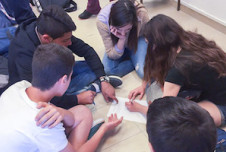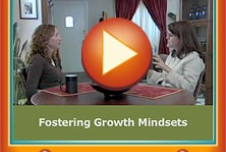When Carol Dweck’s book Mindset came out in 2006, it radically transformed the way people thought about working with young people. Mindset sold over 2 million copies. Whole organizations were created to spread its gospel. Millions of dollars poured in from the federal government and philanthropic communities to promote its practices.

Millions of people became convinced of Mindset’s seminal thesis that what people believe about their abilities has everything to do with how they perform in school and life. For example, those who believe their intelligence can be developed (growth mindset) perform better than those who see it as hardwired at birth (fixed mindset). In other words, success hinges on whether “you believe you can be successful.”
Unfortunately, the results of growth-mindset programs have been underwhelming. In large studies, growth-mindset interventions have not led to improved academic outcomes for students. It’s not because the premise of the growth mindset is wrong. It’s the implementation of the growth mindset that falls short.
Growth-mindset programs have tended to focus on changing students’ mindsets. While there’s truth in the Gautama Buddha quote, “The mind is everything, what you think, you become,” settings can also support or stymie success. What has been overlooked are students’ learning environments.
We’ve asked students to adopt growth mindsets in systems that reinforce and reward fixed mindsets.
It’s akin to recruiting athletes to play football on a volleyball court. If we want students to change their mindsets, we have to change their environments—the very goals, rules, and feedback that make up our education system.
Fixed-mindset education
Currently, students exist in an education system where the goals, rules, and feedback encourage and reward fixed mindsets.
Fixed goals: Winning is everything. Goals in the U.S. education system are fixed by federal and state governments, and passed down to schools and teachers. For example, fixed goals in a calculus course would be to analyze functions using limits, derivatives, and integrals.
In creating objectives and standards that society deems important, education overlooks students’ goals and what’s personally important to them. This is costing students. Less than 50% of U.S. students are engaged in school. Seventy-five percent of students’ feelings about school are negative. Record numbers of students are dropping out of college, or choosing not to go in the first place. Even if students have a growth mindset, they aren’t motivated to work hard in school, if they don’t see how it’s relevant to their lives.
What’s worse, by framing education as a race to get into “elite” colleges and universities, we’re sending a dangerous message that school is a cutthroat, zero-sum competition with few winners and many losers.
We have to ask ourselves: what’s the point of a growth mindset if students don’t see the point in using it?
Fixed rules: The game is rigged. Education systems are replete with fixed rules. You must learn certain material within a certain amount of time, using a certain methodology. An enduring remnant of test-based accountability, born from the No Child Left Behind Act and the Common Core Standards, is the ubiquitous testing required for students to graduate, so teachers can keep their jobs and schools won’t be penalized for poor performance.
An unfortunate outcome of testing is that success becomes contingent on how fast students learn, rather than how much they can grow. Timed tests fly in the face of fostering a growth mindset, which tells students that over time they can learn anything. When students struggle, growth-mindset oriented teachers respond by saying, “You can’t do this, yet.” The word “yet” implies that with enough effort, practice, and time, students can overcome any challenge or adversity.
In reality, the clock is ticking. Learning is not actually about whether students can learn the material eventually, but whether they can learn fast enough to be rewarded through grades and test scores. In a game where the rules make learning time-bound, a growth mindset cannot thrive.
Ultimately, fixed rules rig the game: They will always advantage some students while disadvantaging others. Just as tall people have an advantage in basketball because the “rules” dictate that a basketball rim is 10 feet tall, standardized tests have been shown to disadvantage historically marginalized student populations.
Fixed feedback. In any game, feedback is information that shows whether we are winning or not. Feedback in schools is dominated by grades and grade point averages. Students strive for an A+ because they are rare and thus offer a leg up in the college application process. Or they strive for a C- to maintain their ability to play sports. As a result, grades become the carrots and sticks needed to “motivate students.” In school systems where success is signified by getting into highly rejective colleges, students are taught that it’s not what you learn that counts, it’s your grades.
In centering grades as what’s valued in school, we encourage students to focus on outcomes (a fixed mindset), not the process of learning (a growth mindset). Unfortunately, students who get higher grades tend to show shallow learning styles, reduced intellectual risk-taking, and reduced intrinsic motivation—hallmarks of a fixed mindset. The more emphasis we place on grades, the less students adopt a growth mindset.
For a growth mindset to matter, we must stop forcing students to play fixed games. Addressing this very point, Dweck released a revised edition of her book denouncing the “false” growth mindset and stating, “It is our responsibility to create a context in which a growth mindset can flourish” (emphasis ours). In other words, students can only adopt a growth mindset if we build an environment around them that promotes it. The recently launched Growth Mindset Initiative aims to advance evidence-based teaching practices that promote growth mindset cultures.
As we discuss in our new book, How to Navigate Life: The New Science of Finding Your Way in School, Career, and Beyond, schools and other systems can design growth cultures by changing their goals, rules, and feedback. Here’s how.
Growth goals: Keep it real and relevant
For a growth culture to thrive, its purpose should be student-centered. Classes must feel personally relevant to students so they understand the inherent value of what they are learning. In a growth culture, when students ask, “When will I ever use this in real life?,” their teachers can provide experience-near, personally meaningful answers. Students need to want to learn what they’re being taught. To accomplish that, students must understand how classroom goals have bearing on their personal goals.
 How to Navigate Life: The New Science of Finding Your Way in School, Career, and Beyond (St. Martin's Press, 2022, 320 pages).
How to Navigate Life: The New Science of Finding Your Way in School, Career, and Beyond (St. Martin's Press, 2022, 320 pages).
For some educators, especially ones who perceive their content as highly specialized, this might seem impossible. How do we make learning discrete skills such as analyzing functions, writing a five-paragraph essay, or using APA citation, personally relevant?
Making content relevant involves helping students reflect on the why behind learning various skills. Analyzing functions in calculus is about understanding how and why things change over time. Writing an essay can help you express yourself and give you skills for persuading and arguing your position. Learning APA citation can improve your critical thinking and give you a tool for defending against misinformation. Ask any student: Do you want to get better at expressing your ideas and opinions? Do you want to be able to differentiate fact from fiction? Suddenly, once seemingly irrelevant tasks feel personally meaningful. Connecting the dots between academic content and its personal value to students changes the purpose of school from someone else’s goals to “my” goals.
Creating relatable and relevant course goals also ensures that learning outcomes extend beyond the classroom; they should focus on developing lasting skills that students see the value in using in school, work, and life. Becoming a better communicator and critical thinker is a lifelong process. Such skills have enduring value and diverse utility.
When classroom goals are aligned with each student’s personal and unique goals, every student can be successful. As a result, an inclusive learning environment emerges that not only promotes a growth culture but also has been found to motivate students to work harder, improve their academic performance, and enhance their relationship with their teachers and peers.
To create growth goals, educators can consider: What’s something I hope my students will keep on doing after taking my class, that’s also important to them? What’s the most important thing from this course students should take away into the future?
Growth rules: Be a guide, not a referee
When students see the value in their learning, it changes their relationship with the rules of a class. Growth rules are permissive, not restrictive; they tell students what they can and should do, not what they should not do.
Referees enforce rules and penalize students for not following them. Guides empower students to use the rules to promote learning. In fact, when students are truly motivated in the classroom, they shift from a performance orientation to a mastery mindset by persisting through difficulty, exerting more effort, striving after failure, and seeking challenges. In other words, they actually seek out rules, as rules can provide key information and strategies to help them grow and learn. Rigid rules of a classroom are traded for rules of thumb.
A fixed classroom rule would be to penalize students for arriving late to class and submitting assignments late. These rules only tell students what they should or shouldn’t do. They don’t explain why these rules are important or how they help students learn.
A growth rule reveals why a rule exists: “Students are more happy and successful when they form strong relationships with their peers and teachers. We start every class by getting to know each other better, so give yourself 15 minutes to get to class on time.” Growth rules explain how they can help students thrive: “Students who did well in this class carved out 60 to 90 minutes a week to get their work done on time. I would suggest doing your classwork during my office hours (Tuesdays + Thursdays from 12:00 to 3:00 pm) so you can reach out to me if you get stuck. If those times don’t work with your schedule, we will form study groups during the first week of class.”
Growth rules not only provide different learning strategies (working in groups, seeking out one-on-one support), but they also normalize failure. By showing students what they should do when they struggle, growth rules communicate, “It’s not a question of if you struggle in this class, but when you struggle.”
Educators need not create growth rules unilaterally. They can co-create these rules with their students via community agreements.
When creating classroom rules or agreements (e.g., your syllabi or classroom expectations), educators can consider: Do our growth rules focus on what students should do, or what they shouldn’t do? Do these growth rules provide a variety of learning strategies? Do they tell students what they can do when they are struggling? Do our rules help all students succeed?
Growth feedback: Be a coach, not a critic
Whether we like it or not, in most schools, grades aren’t going away any time soon. So, how can they be leveraged to promote a growth mindset?
Make grading policies insightful, not just informational. Rather than just putting a letter or number on a paper without context, provide specific feedback about what students are doing well and where they can improve, while also providing different strategies to help them overcome difficulties.
Whereas a critic focuses on pointing out flaws, a (good) coach provides timely feedback to help players get better by adjusting their technique and form. Educators can make that same shift from critic to coach by emphasizing formative feedback, rather than stopping at evaluative feedback.
When creating feedback or grading systems, educators can consider: How can my feedback help my students grow? How do I want them to use my grades to get better? Do my grades highlight and reward students’ efforts or their outcomes? Does my feedback inspire continued effort?
The potential of a growth mindset is as great as it’s ever been. Now it’s time to transform fixed games to growth cultures where a growth mindset can truly flourish. This won’t be easy, but no noble mission is.







Comments